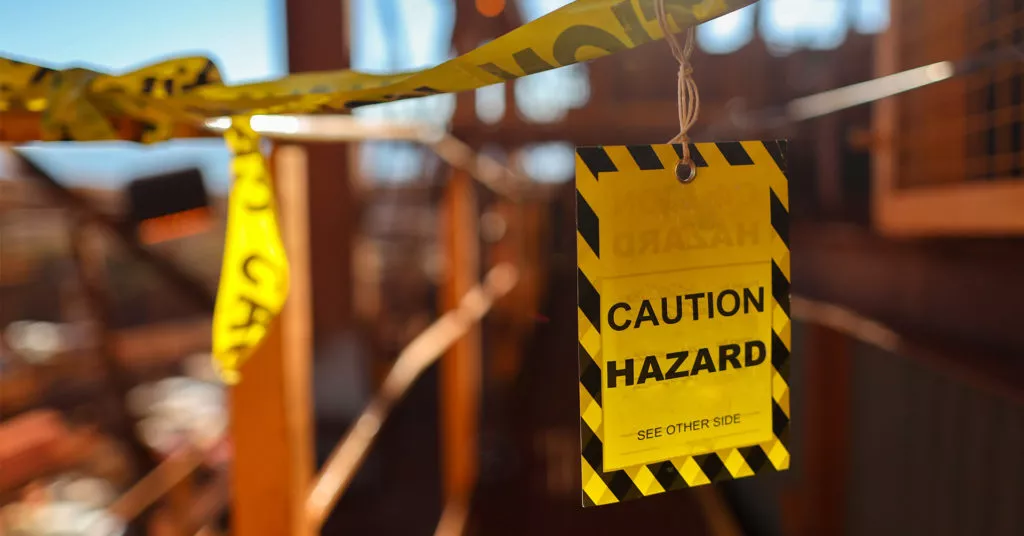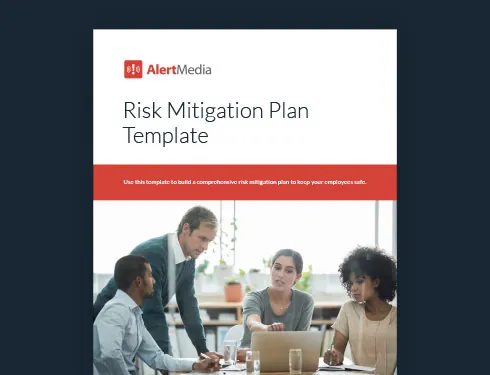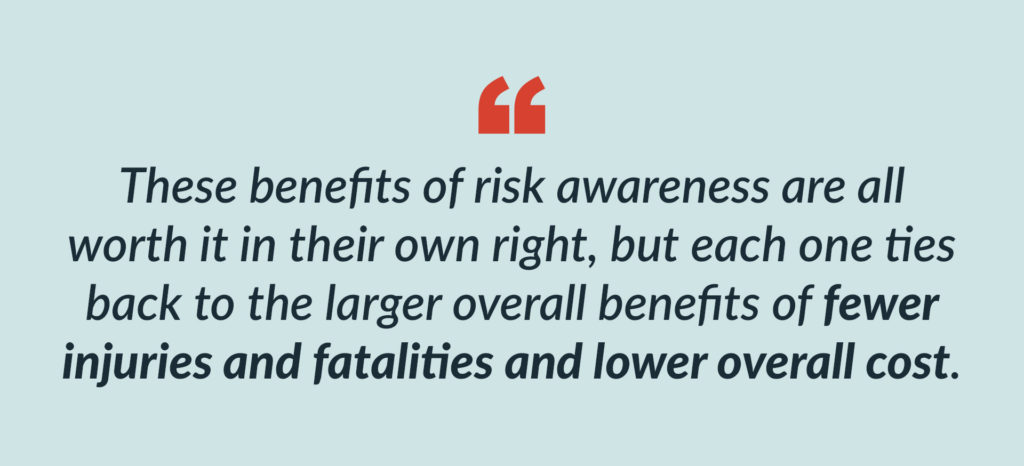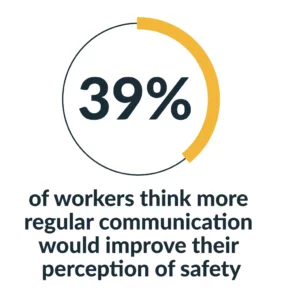
How to Improve Risk Awareness in the Workplace With Practice and Communication
Training your employees in risk awareness will improve your overall emergency preparedness and risk management.

Whether you are one of a whole team of safety leaders, or it’s just you defending your business against all the threats of the world, keeping your business running and your employees safe can feel insurmountable. But you don’t need to be the lone shield for your company’s business continuity.
Every team member at your company has the potential to work as an on-the-ground safety leader. They are the ones in the weeds at your facility, and they have the potential to be your eyes and ears. You just need to teach them what to look for, and how to prepare.
When you arm your employees with risk management skills like risk awareness, you are creating a forcefield of safety around your operations. Think of how many more workplace accidents you can prevent when your employees know how to spot hazards ahead of time. Think of how smooth evacuations could be when employees are aware of approaching threats and have time to act.
“Get the workers involved; they’ll give you the best feedback. They know where the risk is; they know where the challenges are.”Scott Gerard VP of Environmental Health and Safety at Moss Construction
Effective emergency preparedness requires an exceptional risk management process. And by teaching your employees how to practice risk awareness, you are exponentially increasing the number of informed decision makers who can safely navigate the evolving dangers in the modern workplace. In this post, we will walk through how you can include your employees in everyday safety efforts and improve risk awareness in the workplace.
Download Our Risk Mitigation Plan Template
What Is Risk Awareness?
Risk awareness is the ability to spot threats that could impact your business. It is a measure of the breadth of your preparation, not the depth. So risk awareness means you can identify the whole range of threats, not just one or two of the most common or impactful.
Risk awareness is just the first part of your overall risk management strategy. It factors heavily into your company’s risk intelligence—your ability to anticipate, plan for, and respond to a wide array of risks. Your organization’s risk awareness or intelligence is not necessarily enough on its own to prevent harm. But there is no way to respond quickly to a threat that you don’t know is coming, so improving your risk identification and understanding is critical to effective emergency response.
Risk awareness examples in the workplace
In the workplace, risk awareness can look like a lot of different things depending on your industry.
In construction—one of the most hazardous fields—risk awareness might involve:
- Identifying and examining potential hazards on a job site
- Understanding OSHA standards and common violations
- Tracking weather patterns that might impact outdoor labor
Risk awareness in healthcare—another risk-prone industry—might involve:
- Tracking viral outbreaks or pandemic spread
- Identifying the need for additional staff during accident-prone holidays
- Anticipating seasonal natural disasters
The focal points will vary depending on the job, but the root skills are the same everywhere. Risk awareness in the workplace is about knowing what risks you face based on your location and the work you do, understanding how likely these risks are to occur, and anticipating what you should do to prevent or mitigate harm.
Can you teach risk awareness?
Yes, you absolutely can teach and learn risk awareness. As a skill, risk awareness is developed through practical experience. Safety leaders who have been in the industry for decades will likely have higher risk awareness than fresh graduates working their first jobs. But every risk-aware professional started somewhere.
With the right instruction and lots of practice, any employee can improve their risk awareness and help boost the overall safety of the organization. And this post will help you build the foundations necessary to do just that. Keep reading to find four strategies you can integrate into your safety culture today to boost your team’s risk awareness.
What Are the Benefits of Risk Awareness?
Like all the other elements of risk intelligence, risk awareness is a critical piece of your organization’s safety systems. Without a thorough understanding of what threatens your business operations and employee safety, you’ll be unable to adequately prepare. Regularly document and analyze threats to your business continuity with operational risk assessments.
Broad risk awareness has several specific benefits, especially when it comes to making our employees more risk-aware.
- More informed decision making: When you understand what could go wrong, you have a clear opportunity to strategize your response for when they do go wrong. Your team will have the critical information they need to be able to make the right choices during high-stakes situations.
- Quicker risk responses: You will also see a boost in the speed of your emergency response with good risk awareness. When you already know what might happen, you don’t need to spend time wondering what is wrong or how this could have occurred. And your frontline workers will be able to spot and respond much faster to threats.
- Higher risk tolerance levels: When you have a grasp of the different threats to your operations, you will be able to tolerate more risk overall. This is because you are more likely to have risk mitigation efforts in place and won’t be caught by surprise when you’ve already identified risks that are imminent.
These benefits of risk awareness are all worth it in their own right, but each one ties back to the larger benefits of fewer injuries and fatalities and lower overall cost. Risk awareness will set your preparedness efforts up to succeed, so you won’t have to spend as much on emergency response.
Signs of LOW risk awareness
Organizations with low risk awareness are often too focused on one or two specific types of risks. This is typically a function of location. For example, companies in California are very prepared for wildfires but may not have considered other potential threats, like active shooters or tornadoes. Companies in the northeast, like New York, are often very aware of the threat of winter storms—but perhaps not fires, which happen to spike during the winter. Small companies are especially likely to have low-risk awareness.
Signs of HIGH risk awareness
Organizations with high risk awareness consider all the types of risks that can impact employee safety and business continuity. Many of these companies have implemented an all-hazards approach to form the basis of their risk preparedness. Obviously, it’s impossible to create detailed contingency plans for every potential threat, but by identifying every major threat type and creating flexible plans backed by actionable intelligence, you boost your risk intelligence and position your company to make better decisions when responding to unexpected events.
How to Improve Your Team’s Risk Awareness
Since good risk assessment comes from experience, the key to boosting your team’s level of risk awareness is practice. You need to give lots of opportunities for your employees to learn about the risks they face. Here’s how you can present those opportunities in a safe environment.
Hold regular safety meetings
Holding monthly or even weekly safety meetings will give you dedicated time to talk about your business risks and preparedness efforts.
You can use themes or discussion topics to focus the conversation, include presentations of new risks or preparations, invite senior management so there is more visibility into your leadership’s involvement, or use these meetings as open forums. As long as they are consistent and inclusive, they will help keep your business risks top of mind.
Increase your risk communication
As with safety meetings, the goal of your internal communication is to keep your employees thinking about the risks they may face. You don’t want safety put on the back burner while workers focus on getting things done quickly, and you especially don’t want them forgetting common hazards. With frequent communication about risks and safety, you ensure employees won’t get complacent.

Be careful you aren’t sending so many messages that your employees stop listening. To gauge how effective your communication is, send out a questionnaire to gather employee feedback. But research shows that increased communication is a great way to improve how your employees feel about safety in the workplace.
Train for situational awareness
Situational awareness in the workplace is like environment-specific risk awareness. Employees who have been trained in situational awareness will be much more observant of their surroundings. This is great not just for spotting hazards but also for identifying where safety can be improved to prevent hazards.
Situational awareness exercises
Looking for simple ways to improve your team’s situational awareness and observation? Try integrating exercises like these into your regular safety training.
Kim’s Game exercise: This is an exercise focused on training your memory. Test your team members by showing a group of items (in a photo or physical items spread out in a way that they can be shown and then covered up) and challenging them to list as many as they can without looking again.
Observational awareness exercise: This exercise tests how perceptive your team is. Challenge employees to describe the details of a given space—based on their existing observations—without looking around at it.
You can use simple exercises like the Kim’s Game or an observational awareness exercise repeatedly to hone your team members’ memory and practice their reporting skills. These trainings will build a team that is much more aware and better prepared to respond in an emergency.
Learn from past experiences
Nothing is better at improving your employees’ understanding of their risks than scrutinizing past risk events. Ideally, you’ll have all your previous emergencies and procedures documented, whether in a general incident record or a detailed after-action report. These can serve as case studies for what might be likely to happen again.
You can walk employees through the events or even set up tabletop exercises where you practice how to respond. Going through actual events can make these risks feel more real to employees who may see these threats as abstract ideas. It can also set a realistic expectation for how an emergency would go down.
If you don’t have your past events documented, or you have not faced a particular threat you need to train for, you can pose hypotheticals or even reach out to other businesses that have navigated that event.
A Risk-Aware Culture Promotes Safety and Business Continuity
A culture of safety is one of the best ways to improve the security and overall well-being of employees at your organization. And that culture starts with being risk aware.
With guidance and practice, your employees can become your best safety asset, maintaining a state of readiness and awareness. They are your eyes on the ground, seeing and hearing what goes on every day, and they just might be able to spot an oncoming threat that would have been missed without their risk awareness skills.
When threat assessment and preparedness are regular daily practices, every team member is accountable for safety outcomes. With safety champions in every corner at every level, you can minimize harm and maximize business resilience.




